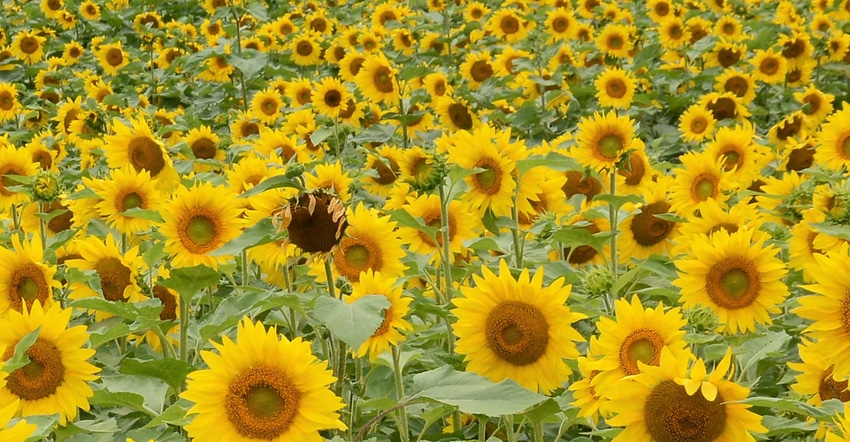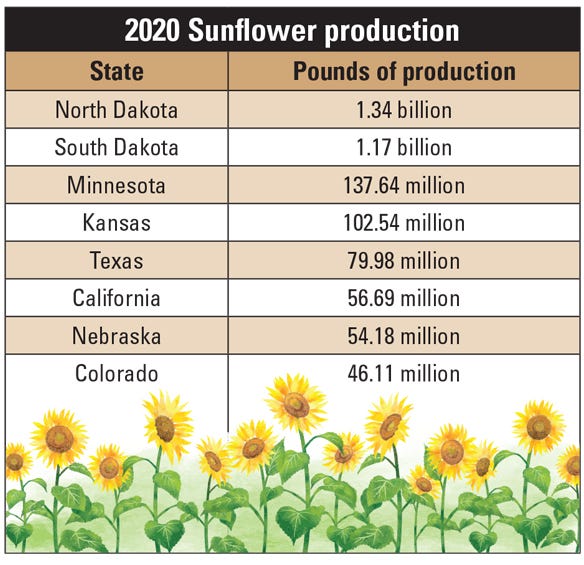
According to USDA, 2020 sunflower production totaled 2.98 billion pounds, up 52% from 2019.
The U.S. average yield per acre of 1,790 pounds increased 230 pounds from 2019 and set a record high average yield for the U.S. planted area, at 1.72 million acres, 27% above the previous year. Area harvested increased 33% from 2019 to 1.67 million acres. Top-producing states are North Dakota, South Dakota, Minnesota, Nebraska and Kansas.
Increase in pounds
North Dakota regained its status as the leading sunflower-producing state last year, with total production of 1.34 billion pounds, an increase of 79%. Compared with 2019, planted area in North Dakota increased 37% and yield increased 356 pounds to 1,872 pounds per acre. Meanwhile, production in South Dakota increased 40% from 2019 to 1.17 billion pounds. Planted acreage in South Dakota, at 622,0000 acres, increased 17% from the previous year. The average yield in South Dakota increased 216 pounds from 2019 to 1,910 pounds per acre.

USDA estimated U.S. production of oil-type sunflower varieties at 2.62 billion pounds, representing an increase of 48% from 2019. Harvested acres were up 28% and the average yield increased by 241 pounds, setting a record high average yield of 1,802 pounds per acre. Production of confection sunflower varieties was estimated at 365 million pounds, an increase of 92% from 2019. Area harvested, at 213,200 acres, was up 74% from 2019. The average yield increased by 157 pounds from 2019 to 1,712 pounds per acre.
Solid oil prices
In its grain stocks report, USDA lowered old crop oil-type sunflower stocks in all positions by 18.4 million pounds, down 8% from its September grain stocks report. Old crop non-oil sunflower stocks were lower slightly by 41,000 pounds. The grain stocks report was in line with trade expectations for both crops.
The sunflower market has been following the trend of stronger oil values. Oil stocks are tighter than a year ago and there are some concerns for palm oil production this year because of pandemic-related labor shortages reducing overall production. This scenario looks promising for high oil content seeds such as sunflower. This fundamental in combination with strong seed demand has led to nearby prices adding $2.30 to $3 per cwt at the crush plants since harvest began. It is very possible that the market low has already been established and prices will remain relatively firm.
The main market mover from April onward will be USDA's March Prospective Plantings report. Trade expectations about planted acreage will likely be in a wide range, but it seems reasonable to expect corn and soybean acreage to increase and spring wheat to show a decrease over 2020 levels.
New crop sunflower prices are penciling out well as crushers and confection processors are out with attractive 2021 production contracts. Another thing to consider is that with sunflower contracts, you have the Act of God clause, which is helpful to lock in a profitable price and reduce some risk. To keep up with price movement, you can go to sunflowersnsa.com.
Sandbakken is the executive director of the National Sunflower Association. He writes from Mandan, N.D.
About the Author(s)
You May Also Like






